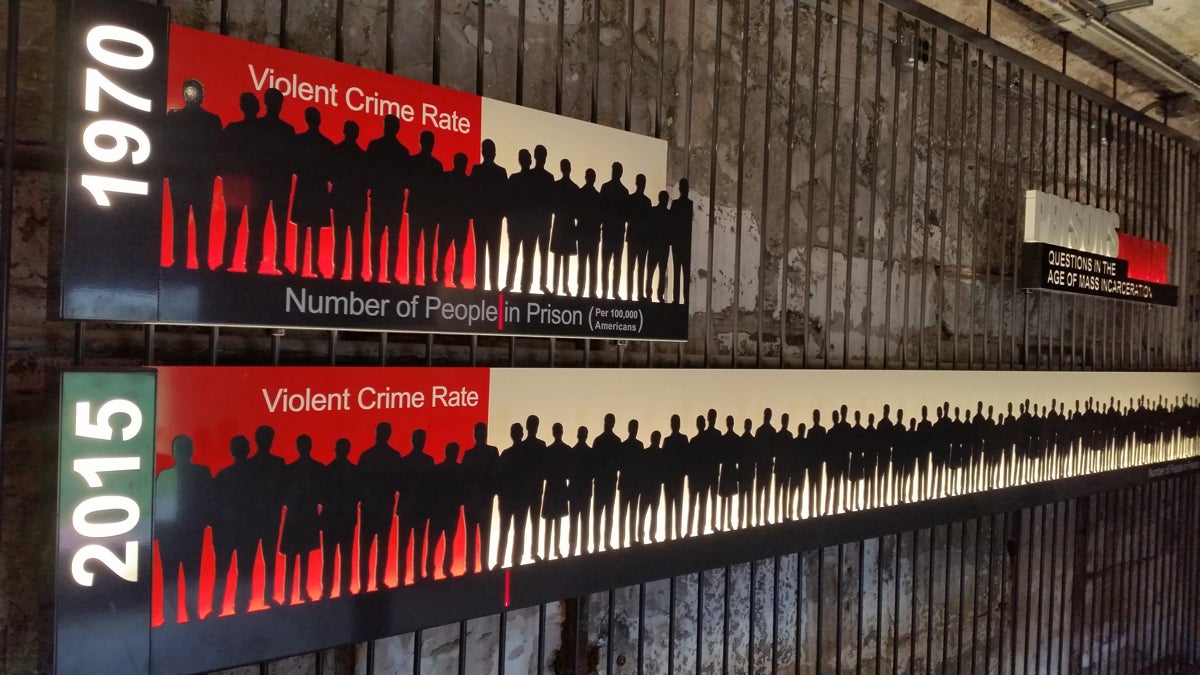Eastern State Penitentiary focus shifts from Al Capone to prison policy

Eastern State Penitentiary's new exhibit
Eastern State Penitentiary, the historic prison site and museum in Philadelphia, has opened a new exhibition about the current state of mass incarceration in America.
It starts with a provocative statement — “mass incarceration isn’t working.”
That’s the first thing you see when you walk into a former prison workshop building, converted into an exhibition space. It’s unusual for a public museum to take such a pointed position.
“We agonized over that point,” said Annie Anderson, senior specialist for research at ESP. “It was a scary thing for us — as an historic site — to say mass incarceration isn’t working. We didn’t want to offend anyone or alienate visitors.”
The museum was originally going to start with something neutral, worded more delicately, like ‘Is mass incarceration working?’
“That’s not honest,” said senior vice president Sean Kelley. “The honest answer is that everyone recognizes it is inefficient, and we have way, way, way more people inside the prisons that is necessary for a safe community.”
The United States has the highest rate of incarceration in the world. According to the exhibition’s statistics, there are 2.2 million people currently behind bars in America, a population rate that has quadrupled over the last 40 years. This is largely due to new incarceration policies, not an uptick in crime: the violent crime rate in American has remained relatively steady.
The exhibit “Prisons Today” looks at the changing political landscape regarding criminal justice with a multi-media timeline of speeches by elected officials set against a steadily climbing incarceration graph. The tough-on-crime arguments of the 1980s began tapering off in the 2000s as many politicians admit their earlier policies were misguided.
There is also a primer of basic prison ideologies, comparing America’s focus on incapacitation — removing criminals from society — to that of other countries which prioritize rehabilitation, or victim retribution, or crime deterrence.
Another section of the show describes the inequitable incarceration rates: you are statistically more likely to be in prison if you are black and poor.
The exhibition represents a new direction for Eastern State Penitentiary, an historic site that had established its reputation based on its dramatically dilapidated 19th century architecture. It’s chief attractions are Al Capone’s lavishly appointed cell, and its annual Halloween tour. Now, the museum is positioning itself to be at the center of what Kelley says will be major criminal justice reforms.
“To really change things, it’s going to take some courageous decisions on the part of elected officials,” said Kelley. “What are those decisions going to be? We don’t have an opinion about what decisions should be made, but those decisions are going to be made.”
The exhibition is so contemporary that its information is constantly changing. On opening day, one of its information boards tracking the voting rights of felons already needed an update: two weeks ago the governor of Virginia extended voting rights to parolees, a move being contested by Republicans in that state.
Eastern State Penitentiary is in the process of created a new strategic plan. Right now America has no national prison museum where issues regarding criminal justice policies can be exhibited publicly. The board of ESP is reaching for that ring.
“They are very serious about the role this organization can play in a national discussion about the criminal justice system,” said Kelley.
WHYY is your source for fact-based, in-depth journalism and information. As a nonprofit organization, we rely on financial support from readers like you. Please give today.





